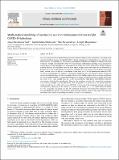| dc.description.abstract | The world experienced the life-threatening COVID-19 disease worldwide since its inversion. The whole world
experienced difficult moments during the COVID-19 period, whereby most individual lives were affected by the
disease socially and economically. The disease caused millions of illnesses and hundreds of thousands of deaths
worldwide. To fight and control the COVID-19 disease intensity, mathematical modeling was an essential tool
used to determine the potentiality and seriousness of the disease. Due to the effects of the COVID-19 disease,
scientists observed that vaccination was the main option to fight against the disease for the betterment of
human lives and the world economy. Unvaccinated individuals are more stressed with the disease, hence their
body’s immune system are affected by the disease. In this study, the 𝑆𝑉 𝐸𝐼𝐻𝑅 deterministic model of COVID-
19 with six compartments was proposed and analyzed. Analytically, the next-generation matrix method was
used to determine the basic reproduction number (𝑅0). Detailed stability analysis of the no-disease equilibrium
(𝐸0) of the proposed model to observe the dynamics of the system was carried out and the results showed that
𝐸0 is stable if 𝑅0 < 1 and unstable when 𝑅0 > 1. The Bayesian Markov Chain Monte Carlo (MCMC) method for
the parameter identifiability was discussed. Moreover, the sensitivity analysis of 𝑅0 showed that vaccination
was an essential method to control the disease. With the presence of a vaccine in our 𝑆𝑉 𝐸𝐼𝐻𝑅 model, the
results showed that 𝑅0 = 0.208, which means COVID-19 is fading out of the community and hence minimizes
the transmission. Moreover, in the absence of a vaccine in our model, 𝑅0 = 1.7214, which means the disease
is in the community and spread very fast. The numerical simulations demonstrated the importance of the
proposed model because the numerical results agree with the sensitivity results of the system. The numerical
simulations also focused on preventing the disease to spread in the community | en_US |

